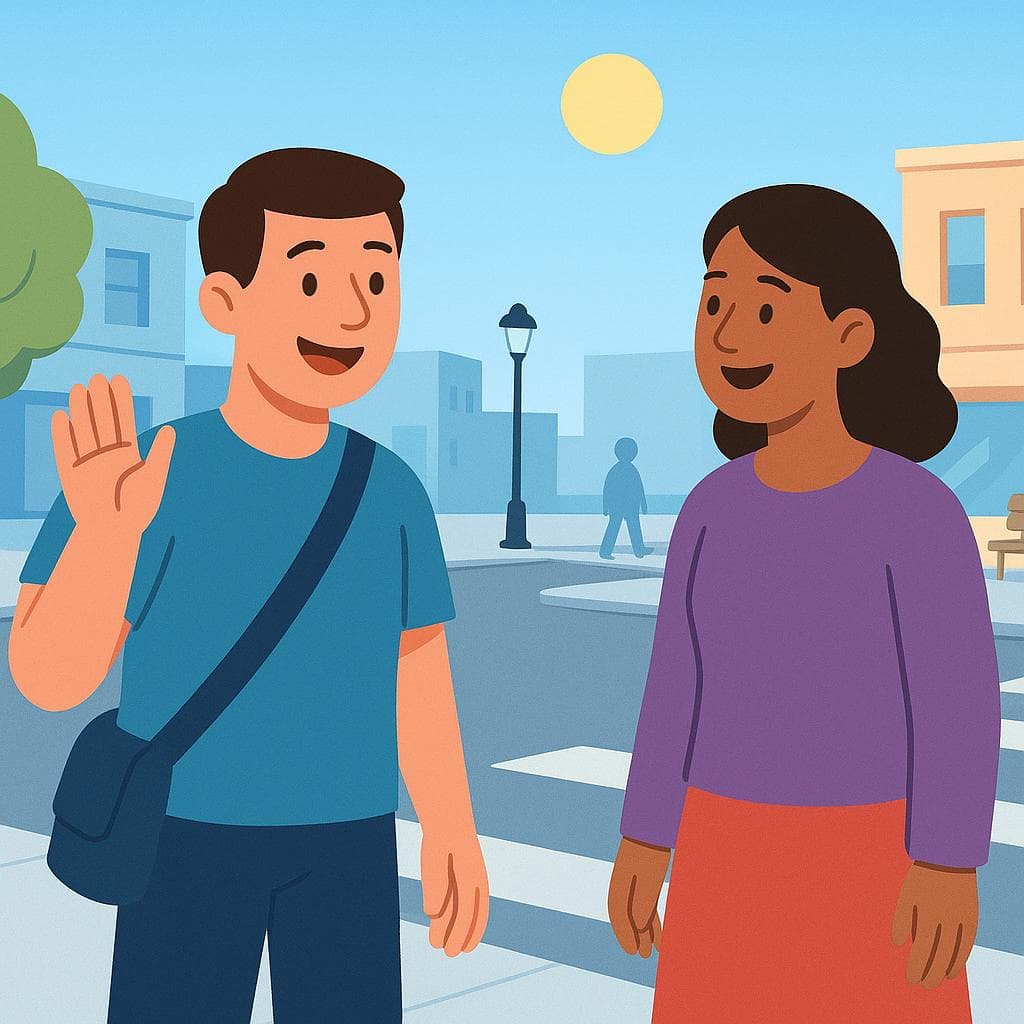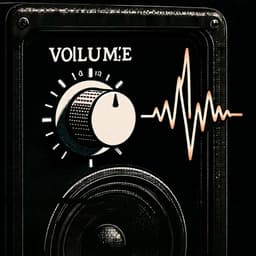Good afternoon
in SpanishBuenas tardes
/BWEH-nahs TAR-dehs/
This is the standard, universal way to say 'Good afternoon' in Spanish. It's appropriate in any situation, from casual to formal, and is the most important version to learn.

A simple 'Buenas tardes' is the perfect, friendly way to greet someone you meet in the afternoon.
💬Other Ways to Say It
¡Buenas!
/BWEH-nahs/
A very common, friendly, and abbreviated greeting. It's a catch-all that can mean 'Good morning,' 'Good afternoon,' or 'Good evening,' depending on the time of day.
Que tengas buenas tardes
/keh TEHN-gahs BWEH-nahs TAR-dehs/
This means 'Have a good afternoon.' It's not used as a greeting when you arrive, but as a farewell when you're leaving.
Que tenga buenas tardes
/keh TEHN-gah BWEH-nahs TAR-dehs/
This is the formal version of 'Have a good afternoon,' used when you want to show respect.
Muy buenas tardes
/Mwee BWEH-nahs TAR-dehs/
A slightly more formal and emphatic version of 'Buenas tardes.' The 'Muy' (very) adds a layer of politeness and warmth.
🔑Key Words
Key Words to learn:
📊Quick Comparison
Here's a quick comparison of the main ways to say 'Good afternoon' to help you choose the right one for the situation.
| Phrase | Formality | Best For | Avoid When |
|---|---|---|---|
| Buenas tardes | Neutral | Greeting anyone in almost any situation; it's always a safe choice. | Never truly wrong, but '¡Buenas!' can feel more natural with close friends. |
| ¡Buenas! | Casual | Quick, friendly greetings with peers, friends, or in shops and cafes. | Very formal business meetings or when addressing a figure of authority. |
| Muy buenas tardes | Formal | Showing extra respect to elders, clients, or when starting a formal presentation. | Casual chats with friends, as it can sound a bit stiff. |
| Que tengas/tenga buenas tardes | Informal/Formal | Saying goodbye to someone in the afternoon. | As an initial greeting; it's strictly a farewell phrase. |
📈Difficulty Level
Fairly easy for English speakers. The 'r' in 'tardes' is a single tap of the tongue, softer than a hard English 'r'.
It's a fixed phrase, so no complex grammar is involved for the basic greeting. You just need to memorize it.
The main challenge is cultural: knowing when the 'afternoon' begins and ends, which is more flexible and tied to daylight and meal times than in English.
Key Challenges:
- Remembering to use the feminine 'buenas' with the feminine 'tardes'
- Knowing when to switch from 'Buenas tardes' to 'Buenas noches'
💡Examples in Action
Buenas tardes, señorita García. ¿Cómo está usted?
Good afternoon, Miss Garcia. How are you?
¡Hola, chicos! ¡Buenas! ¿Listos para el partido?
Hey, guys! Hey! Ready for the game?
Gracias por todo. Que tenga buenas tardes.
Thank you for everything. Have a good afternoon.
Ya me voy a casa. ¡Que tengas buenas tardes, Pablo!
I'm heading home now. Have a good afternoon, Pablo!
🌍Cultural Context
When Does 'Afternoon' Actually Start?
In many Spanish-speaking countries, the 'afternoon' (la tarde) doesn't start at 12:00 PM on the dot. It generally begins after the main midday meal, which can be anywhere from 1:30 PM to 3:00 PM. So, don't be surprised if you still hear 'Buenos días' at 1 PM!
Why Is It Always Plural?
You'll notice it's 'Buenas tardes' (plural), not 'Buena tarde' (singular). This is a set pattern for greetings in Spanish: 'Buenos días' (Good morning), 'Buenas tardes' (Good afternoon), and 'Buenas noches' (Good evening/night). Think of it as wishing someone many good hours in that part of the day.
The Obligatory Greeting
In many parts of the Spanish-speaking world, it's considered polite and essential to greet people when you enter a small, enclosed space. Whether it's a doctor's waiting room, a small shop, or an elevator, a simple 'Buenas tardes' to the room at large is a common courtesy.
A Long Afternoon
The 'tarde' can last much longer than you might expect. People often say 'Buenas tardes' until the sun goes down. In summer in Spain, this means you could still be saying it at 8 or 9 PM, right before you switch to 'Buenas noches'.
❌ Common Pitfalls
Using 'Bueno' Instead of 'Buenas'
Mistake: "A common mistake is saying 'Bueno tardes'."
Correction: The correct phrase is 'Buenas tardes'.
Forgetting the 'S' at the End
Mistake: "Sometimes learners say 'Buenas tarde' without the final 's'."
Correction: Always say 'Buenas tardes'.
Mixing Up Greetings and Farewells
Mistake: "Using 'Que tengas buenas tardes' to greet someone."
Correction: Use 'Buenas tardes' for a greeting and 'Que tengas buenas tardes' for a farewell.
💡Pro Tips
When in Doubt, Use '¡Buenas!'
If you're in a casual situation and can't remember if it's morning, afternoon, or evening, '¡Buenas!' is your best friend. It's a super common, friendly, and safe catch-all greeting.
Match Their Formality
Pay attention to how someone greets you. If a stranger says 'Muy buenas tardes, ¿en qué le puedo ayudar?' (A very good afternoon, how can I help you?), it's best to respond with a similar level of politeness, like 'Buenas tardes'.
How to Respond
The easiest and most common way to respond to 'Buenas tardes' is simply to say it back: 'Buenas tardes'. You can also say 'Hola, buenas tardes' or 'Igualmente' (Likewise), especially if they said 'Que tenga buenas tardes' as you were leaving.
🗺️Regional Variations
Spain
The transition from 'tardes' to 'noches' happens very late, often after 8 or 9 PM, especially in summer. This is tied to the late dinner schedule. Greeting with 'Buenas tardes' when entering a shop is very common.
Mexico
It's considered very polite and almost mandatory to greet people with 'Buenas tardes' upon entering any establishment. The timing is flexible but usually starts after 1 PM or after the main midday meal.
Argentina
Usage is standard and similar to other regions. Like in Spain, the afternoon can extend late into the evening before people switch to 'Buenas noches'. Using 'vos' instead of 'tú' is standard, so a farewell would be 'Que tengas buenas tardes'.
💬What Comes Next?
After you greet someone with 'Buenas tardes'
Buenas tardes. ¿Cómo está?
Good afternoon. How are you?
Muy bien, gracias. ¿Y usted?
Very well, thank you. And you?
After you say goodbye with 'Que tenga buenas tardes'
Gracias, igualmente.
Thank you, likewise.
De nada. ¡Hasta luego!
You're welcome. See you later!
When you greet a shopkeeper
Buenas tardes. ¿En qué le puedo ayudar?
Good afternoon. How can I help you?
Hola, buenas. Solo estoy mirando, gracias.
Hi, hello. I'm just looking, thank you.
🔄How It Differs from English
In Spanish, greetings like 'Buenas tardes' are always plural, unlike the singular 'Good afternoon.' The concept of 'afternoon' is also culturally defined by meal times (after the main lunch) and daylight hours, not a strict clock time like noon. Furthermore, using these greetings when entering small public spaces is a much stronger social expectation than in many English-speaking cultures.
Spanish culture generally expects greetings more consistently than English-speaking cultures. Walking into a small shop or an elevator without acknowledging others with a 'Buenas tardes' can be perceived as cold or rude.
🎯Your Learning Path
➡️ Learn Next:
How to say Good morning
It's the greeting that comes before 'Good afternoon' in the daily cycle.
How to say Good evening/night
This completes the set of essential daily greetings.
How to say How are you?
This is the most common follow-up question after any greeting.
How to say Goodbye
Knowing how to end the conversation is as important as starting it.
✏️Test Your Knowledge
💡 Quick Quiz: Good afternoon
Question 1 of 4
You walk into a small bakery in Spain at 3 PM. What is the most appropriate thing to say to the baker?
Frequently Asked Questions
What's the literal translation of 'Buenas tardes'?
Literally, 'Buenas tardes' translates to 'Good afternoons' (plural). While it sounds a bit strange in English, it's part of a standard pattern in Spanish greetings ('Buenos días', 'Buenas noches') that wishes someone well for the entire duration of that time period.
At exactly what time should I switch from 'Buenos días' to 'Buenas tardes'?
There's no strict rule, and it varies by region. A safe bet is to switch around 1 PM or after the main midday meal. If you're unsure, just listen to what others are saying. Don't worry too much; no one will be offended if you're an hour off.
And when do I switch from 'Buenas tardes' to 'Buenas noches'?
This switch is usually tied to sunset. When it starts getting dark outside, that's when you should start saying 'Buenas noches'. This can be as early as 6 PM in the winter or as late as 9 PM in the summer in places like Spain.
Is '¡Buenas!' rude or too informal?
Not at all! In casual contexts, '¡Buenas!' is extremely common and friendly. It's perfect for greeting a neighbor, a cashier at the supermarket, or friends. Just avoid it in very formal situations, like a job interview or a business meeting.
How do I reply if someone says 'Buenas tardes' to me?
The simplest and most common response is to say it right back: 'Buenas tardes'. You can also say 'Hola, buenas tardes' to be extra friendly, or 'Igualmente' (Likewise) if they are wishing you a good afternoon as a farewell.
Can I just say 'Hola' in the afternoon?
Yes, you can absolutely say 'Hola' anytime. However, following it up with 'Buenas tardes' (e.g., 'Hola, buenas tardes') is often warmer and more polite, especially when greeting someone for the first time that day.
📚Continue Learning Spanish Phrases
Explore More Phrases in These Categories
Find similar phrases to expand your Spanish vocabulary:
Want to Learn More Spanish Phrases?
Browse our complete collection of Spanish phrases organized by situation, from basic greetings to advanced conversations. Perfect for travelers, students, and anyone learning Spanish.
View All Spanish Phrases →


